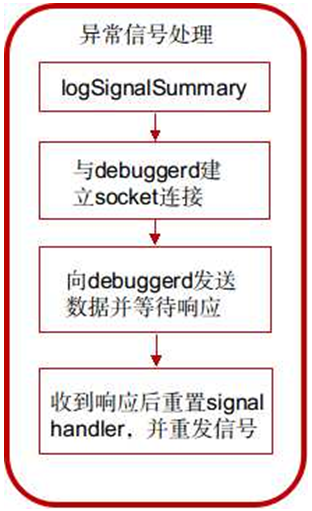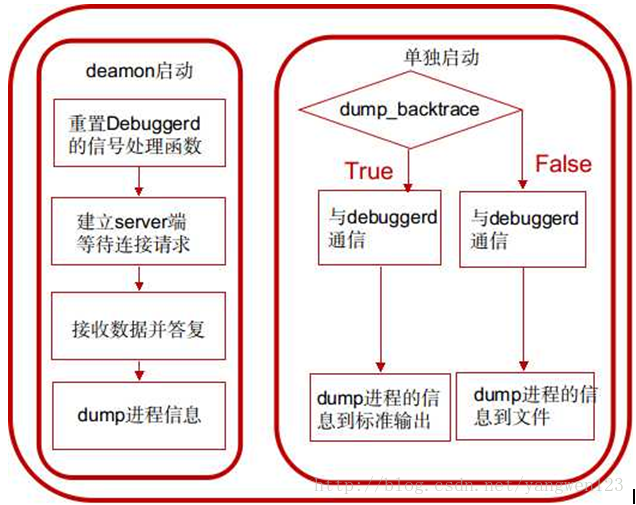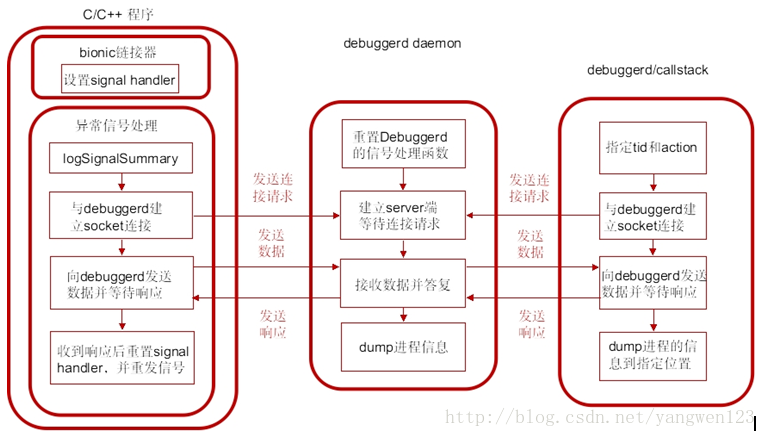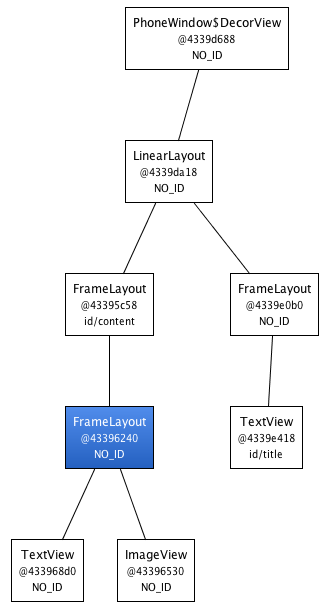編輯:關於Android編程
Android系統自帶一個實用的程序異常退出的診斷daemon debuggerd。此進程可以偵測到程序崩潰,並將崩潰時的進程狀態信息輸出到文件和串口中,以供開發人員分析調試使用。Debuggerd的數據被保存在/data/tombstone/目錄下,共可保存10個文件,當超過10個時,會覆蓋重寫最早生產的文件。串口中,則直接用DEBUG的tag,輸出logcat信息。 Linux kernel有自己的一套signal機制,在應用程序崩潰時,通常系統內核都會發送signal到出問題的進程,以通知進程出現什麼異常,這些進程可以捕獲這些signal並對其做相應的處理。通常對於程序異常信號的處理,就是退出。Android在此機制上實現了一個更實用的功能:攔截這些信號,dump進程信息以供調試。
debuggerd創建一個名為 “Android:debuggerd”的socket,作為server端等待其他client端進程的連接,接收client端進程發送來的tid和action信息將由tid指定的那個進程的運行信息,按照由action指定的動作dump到文件或者控制台中可以作為debuggerd的client端的進程主要有幾種:
1. 異常的C/C++程序
這種程序由bionic的linker安裝異常信號的處理函數,當程序產生異常信號時,進入信號處理函數,與debuggerd建立。
2. debuggerd程序
debuggerd可以在控制台中以命令debuggerd -b [
3. dumpstate
控制台中運行命令dumpstate,並指定必要的參數,命令中會調用dump_backtrace_to_file與debuggerd交互。
產生異常信號的C/C++程序與debuggerd建立連接後,debuggerd將進程信息dump到tombstone_XX文件中保存到/data/tombstone/文件夾下。可通過查看tombstone_XX分析異常進程的堆棧信息。
在控制台中以命令debuggerd -b [
應用程序入口屬於bionic實現的一部分,則對所有android的程序有效。在應用程序入口地址__start後,__linker_init中調用debugger_init()函數來注冊異常信號處理handler,以實現攔截系統異常的幾個singal:SIGILL,SIGABRT, SIGBUS, SIGFPE,SIGSEGV和SIGPIPE:
linker/arch/arm/begin.S
start:
mov r0, sp
mov r1, #0
bl __linker_init
bionic\linker\ Linker.cpp
extern "C" Elf32_Addr __linker_init(void* raw_args) {
…
Elf32_Addr start_address = __linker_init_post_relocation(args, linker_addr);
set_soinfo_pool_protection(PROT_READ);
// Return the address that the calling assembly stub should jump to.
return start_address;
}
static Elf32_Addr __linker_init_post_relocation(KernelArgumentBlock& args, Elf32_Addr linker_base) {
...
debuggerd_init();
...
}
bionic\linker\Debugger.c
void debugger_init()
{
struct sigaction act;
memset(&act, 0, sizeof(act));
act.sa_sigaction = debugger_signal_handler;
act.sa_flags = SA_RESTART | SA_SIGINFO;
sigemptyset(&act.sa_mask);
sigaction(SIGILL, &act, NULL);
sigaction(SIGABRT, &act, NULL);
sigaction(SIGBUS, &act, NULL);
sigaction(SIGFPE, &act, NULL);
sigaction(SIGSEGV, &act, NULL);
sigaction(SIGSTKFLT, &act, NULL);
sigaction(SIGPIPE, &act, NULL);
}
bionic庫中的鏈接器會對以下七種信號設置Handler(debugger_signal_handler):
debugger_init中act.sa_flags = SA_RESTART | SA_SIGINFO的涵義:
1) SA_RESTART
如果指定該參數,表示若信號中斷了進程的某個系統調用,則系統自動啟動該系統調用。如果不指定該參數,則被中斷的系統調用返回失敗,錯誤碼為EINTR。這個標志位只要用於處理慢系統調用(可能會被阻塞的系統調用)。比如調用write系統調用寫某個設備被阻塞,這時進程捕獲某個信號且進入相應信號處理函數返回時,該系統調用可能要返回ENINTR錯誤。指定這個參數後,系統調用會重啟,與RETRY_ON_EINTR宏配合使用則可以保證寫操作的完成
2) SA_SIGINFO
如果指定該參數,表示信號附帶的參數(siginfo_t結構體)可以被傳遞到信號處理函數中。
鏈接到bionic庫上的C/C++程序崩潰時,內核會發送相應的signal,進程收到異常信號後,會轉入debugger_signal_handler函數中進行處理。
void debugger_signal_handler(int n, siginfo_t* info, void* unused)
{
char msgbuf[128];
unsigned tid;
int s;
logSignalSummary(n, info);
tid = gettid();
//"android:debuggerd"
s = socket_abstract_client(DEBUGGER_SOCKET_NAME, SOCK_STREAM);
if (s >= 0) {
/* debugger knows our pid from the credentials on the
* local socket but we need to tell it our tid. It
* is paranoid and will verify that we are giving a tid
* that's actually in our process
*/
int ret;
debugger_msg_t msg;
msg.action = DEBUGGER_ACTION_CRASH;
msg.tid = tid;
RETRY_ON_EINTR(ret, write(s, &msg, sizeof(msg)));
if (ret == sizeof(msg)) {
/* if the write failed, there is no point to read on
* the file descriptor. */
RETRY_ON_EINTR(ret, read(s, &tid, 1));
int savedErrno = errno;
notify_gdb_of_libraries();
errno = savedErrno;
}
if (ret < 0) {
/* read or write failed -- broken connection? */
format_buffer(msgbuf, sizeof(msgbuf),
"Failed while talking to debuggerd: %s", strerror(errno));
__libc_android_log_write(ANDROID_LOG_FATAL, "libc", msgbuf);
}
close(s);
} else {
/* socket failed; maybe process ran out of fds */
format_buffer(msgbuf, sizeof(msgbuf),
"Unable to open connection to debuggerd: %s", strerror(errno));
__libc_android_log_write(ANDROID_LOG_FATAL, "libc", msgbuf);
}
/* remove our net so we fault for real when we return */
signal(n, SIG_DFL);
/*
* These signals are not re-thrown when we resume. This means that
* crashing due to (say) SIGPIPE doesn't work the way you'd expect it
* to. We work around this by throwing them manually. We don't want
* to do this for *all* signals because it'll screw up the address for
* faults like SIGSEGV.
*/
switch (n) {
case SIGABRT:
case SIGFPE:
case SIGPIPE:
case SIGSTKFLT:
(void) tgkill(getpid(), gettid(), n);
break;
default: // SIGILL, SIGBUS, SIGSEGV
break;
}
}
debugger_signal_handler函數處理流程:

1) 調用logSignalSummary將signal信息寫入文件;
static void logSignalSummary(int signum, const siginfo_t* info)
{
char buffer[128];
char threadname[MAX_TASK_NAME_LEN + 1]; // one more for termination
char* signame;
switch (signum) {
case SIGILL: signame = "SIGILL"; break;
case SIGABRT: signame = "SIGABRT"; break;
case SIGBUS: signame = "SIGBUS"; break;
case SIGFPE: signame = "SIGFPE"; break;
case SIGSEGV: signame = "SIGSEGV"; break;
case SIGSTKFLT: signame = "SIGSTKFLT"; break;
case SIGPIPE: signame = "SIGPIPE"; break;
default: signame = "???"; break;
}
if (prctl(PR_GET_NAME, (unsigned long)threadname, 0, 0, 0) != 0) {
strcpy(threadname, "");
} else {
// short names are null terminated by prctl, but the manpage
// implies that 16 byte names are not.
threadname[MAX_TASK_NAME_LEN] = 0;
}
format_buffer(buffer, sizeof(buffer),
"Fatal signal %d (%s) at 0x%08x (code=%d), thread %d (%s)",
signum, signame, info->si_addr, info->si_code, gettid(), threadname);
__libc_android_log_write(ANDROID_LOG_FATAL, "libc", buffer);
}
獲取異常信號的名字和thread名字,並格式化字符串,調用函數__libc_android_log_write函數寫入”/dev/log/main”中。
2) 調用socket_abstract_client函數與debuggerd建立socket連接;
s = socket_abstract_client(DEBUGGER_SOCKET_NAME, SOCK_STREAM);
3) 如果連接建立成功,則設置結構體debugger_msg_t,並發送給debuggerd;
msg.action = DEBUGGER_ACTION_CRASH;//告訴debuggerd采取何種行 msg.tid = tid;//線程號 RETRY_ON_EINTR(ret, write(s, &msg, sizeof(msg)));
4) 等待debuggerd的回復,阻塞在下面的調用中,收到回復後接著執行下面的流程;
RETRY_ON_EINTR(ret, read(s, &tid, 1));
5) 重新設置信號處理函數為SIG_DFL,即采取默認的動作;
signal(n, SIG_DFL);
6) 重新發送信號,進程從當前信號處理函數返回後,會處理這個信號,進行默認的信號處理動作,即中斷進程。
1. 在init進程中以deamon的方式啟動,在init.rc中
service debuggerd /system/bin/debuggerd class main
以這種方式啟動的話,進入main函數後,將調用do_server函數,作為server端為其他進程提供dump進程信息的服務。
2. 直接運行system/bin/debuggerd可執行文件,需要指定參數,用法為:
debuggerd -b [] //參數-b表示在控制台中輸出backtrace
以這種方式啟動的話,進入main函數後,將調用do_explicit_dump函數與debuggerd daemon通信,將指定進程的信息dump到文件或控制台。
 vcq9PC9oND4KPHByZSBjbGFzcz0="brush:java;">int main(int argc, char** argv) {
if (argc == 1) {
return do_server();
}
}
vcq9PC9oND4KPHByZSBjbGFzcz0="brush:java;">int main(int argc, char** argv) {
if (argc == 1) {
return do_server();
}
}
當啟動debuggerd進程傳遞的參數個數為1時,此時啟動的debuggerd將作為一個後台服務進程,專門接收應用程序異常退出消息而產生tombstone。
static int do_server() {
int s;
struct sigaction act;
int logsocket = -1;
/*
* debuggerd crashes can't be reported to debuggerd. Reset all of the
* crash handlers.
*/
signal(SIGILL, SIG_DFL);
signal(SIGABRT, SIG_DFL);
signal(SIGBUS, SIG_DFL);
signal(SIGFPE, SIG_DFL);
signal(SIGSEGV, SIG_DFL);
signal(SIGPIPE, SIG_IGN);
signal(SIGSTKFLT, SIG_DFL);
logsocket = socket_local_client("logd",
ANDROID_SOCKET_NAMESPACE_ABSTRACT, SOCK_DGRAM);
if(logsocket < 0) {
logsocket = -1;
} else {
fcntl(logsocket, F_SETFD, FD_CLOEXEC);
}
act.sa_handler = SIG_DFL;
sigemptyset(&act.sa_mask);
sigaddset(&act.sa_mask,SIGCHLD);
act.sa_flags = SA_NOCLDWAIT;
sigaction(SIGCHLD, &act, 0);
s = socket_local_server(DEBUGGER_SOCKET_NAME,
ANDROID_SOCKET_NAMESPACE_ABSTRACT, SOCK_STREAM);
if(s < 0) return 1;
fcntl(s, F_SETFD, FD_CLOEXEC);
LOG("debuggerd: " __DATE__ " " __TIME__ "\n");
//check corefile limit.
(void)check_corefile_limit();
for(;;) {
struct sockaddr addr;
socklen_t alen;
int fd;
alen = sizeof(addr);
XLOG("waiting for connection\n");
fd = accept(s, &addr, &alen);
if(fd < 0) {
XLOG("accept failed: %s\n", strerror(errno));
continue;
}
fcntl(fd, F_SETFD, FD_CLOEXEC);
handle_request(fd);
}
return 0;
}
1. 忽略debuggerd自身crash的處理;
2. 建立socket通信的server端;
3. 進入無限循環中,等待並接收客戶端進程連接請求,並通過handle_request()函數處理請求;
static void handle_request(int fd) {
XLOG("handle_request(%d)\n", fd);
debugger_request_t request;
int status = read_request(fd, &request);
if (!status) {
XLOG("BOOM: pid=%d uid=%d gid=%d tid=%d\n",
request.pid, request.uid, request.gid, request.tid);
/* At this point, the thread that made the request is blocked in
* a read() call. If the thread has crashed, then this gives us
* time to PTRACE_ATTACH to it before it has a chance to really fault.
*
* The PTRACE_ATTACH sends a SIGSTOP to the target process, but it
* won't necessarily have stopped by the time ptrace() returns. (We
* currently assume it does.) We write to the file descriptor to
* ensure that it can run as soon as we call PTRACE_CONT below.
* See details in bionic/libc/linker/debugger.c, in function
* debugger_signal_handler().
*/
if (ptrace(PTRACE_ATTACH, request.tid, 0, 0)) {
LOG("ptrace attach failed: %s\n", strerror(errno));
} else {
bool detach_failed = false;
bool attach_gdb = should_attach_gdb(&request);
if (TEMP_FAILURE_RETRY(write(fd, "\0", 1)) != 1) {
LOG("failed responding to client: %s\n", strerror(errno));
} else {
char* tombstone_path = NULL;
if (request.action == DEBUGGER_ACTION_CRASH) {
close(fd);
fd = -1;
}
int total_sleep_time_usec = 0;
for (;;) {
int signal = wait_for_signal(request.tid, &total_sleep_time_usec);
if (signal < 0) {
break;
}
switch (signal) {
case SIGSTOP:
if (request.action == DEBUGGER_ACTION_DUMP_TOMBSTONE) {
XLOG("stopped -- dumping to tombstone\n");
tombstone_path = engrave_tombstone(request.pid, request.tid,
signal, true, true, &detach_failed,
&total_sleep_time_usec);
} else if (request.action == DEBUGGER_ACTION_DUMP_BACKTRACE) {
XLOG("stopped -- dumping to fd\n");
dump_backtrace(fd, request.pid, request.tid, &detach_failed,
&total_sleep_time_usec);
} else {
XLOG("stopped -- continuing\n");
status = ptrace(PTRACE_CONT, request.tid, 0, 0);
if (status) {
LOG("ptrace continue failed: %s\n", strerror(errno));
}
continue; /* loop again */
}
break;
case SIGILL:
case SIGABRT:
case SIGBUS:
case SIGFPE:
case SIGSEGV:
case SIGSTKFLT: {
XLOG("stopped -- fatal signal\n");
/*
* Send a SIGSTOP to the process to make all of
* the non-signaled threads stop moving. Without
* this we get a lot of "ptrace detach failed:
* No such process".
*/
kill(request.pid, SIGSTOP);
/* don't dump sibling threads when attaching to GDB because it
* makes the process less reliable, apparently... */
tombstone_path = engrave_tombstone(request.pid, request.tid,
signal, !attach_gdb, false, &detach_failed,
&total_sleep_time_usec);
break;
}
case SIGPIPE:
LOG("socket-client process stopped due to SIGPIPE! \n");
break;
default:
XLOG("stopped -- unexpected signal\n");
LOG("process stopped due to unexpected signal %d\n", signal);
break;
}
break;
}
if (request.action == DEBUGGER_ACTION_DUMP_TOMBSTONE) {
if (tombstone_path) {
write(fd, tombstone_path, strlen(tombstone_path));
}
close(fd);
fd = -1;
}
free(tombstone_path);
}
XLOG("detaching\n");
if (attach_gdb) {
/* stop the process so we can debug */
kill(request.pid, SIGSTOP);
/* detach so we can attach gdbserver */
if (ptrace(PTRACE_DETACH, request.tid, 0, 0)) {
LOG("ptrace detach from %d failed: %s\n", request.tid, strerror(errno));
detach_failed = true;
}
/*
* if debug.db.uid is set, its value indicates if we should wait
* for user action for the crashing process.
* in this case, we log a message and turn the debug LED on
* waiting for a gdb connection (for instance)
*/
wait_for_user_action(request.pid);
} else {
/* just detach */
if (ptrace(PTRACE_DETACH, request.tid, 0, 0)) {
LOG("ptrace detach from %d failed: %s\n", request.tid, strerror(errno));
detach_failed = true;
}
}
/* resume stopped process (so it can crash in peace). */
kill(request.pid, SIGCONT);
/* If we didn't successfully detach, we're still the parent, and the
* actual parent won't receive a death notification via wait(2). At this point
* there's not much we can do about that. */
if (detach_failed) {
LOG("debuggerd committing suicide to free the zombie!\n");
kill(getpid(), SIGKILL);
}
}
}
if (fd >= 0) {
close(fd);
}
}
1) 調用read_request函數讀取client端進程發送來的數據:
static int read_request(int fd, debugger_request_t* out_request) {
struct ucred cr;
int len = sizeof(cr);
int status = getsockopt(fd, SOL_SOCKET, SO_PEERCRED, &cr, &len);
if (status != 0) {
LOG("cannot get credentials\n");
return -1;
}
XLOG("reading tid\n");
fcntl(fd, F_SETFL, O_NONBLOCK);
struct pollfd pollfds[1];
pollfds[0].fd = fd;
pollfds[0].events = POLLIN;
pollfds[0].revents = 0;
status = TEMP_FAILURE_RETRY(poll(pollfds, 1, 3000));
if (status != 1) {
LOG("timed out reading tid\n");
return -1;
}
debugger_msg_t msg;
status = TEMP_FAILURE_RETRY(read(fd, &msg, sizeof(msg)));
if (status < 0) {
LOG("read failure? %s\n", strerror(errno));
return -1;
}
if (status != sizeof(msg)) {
LOG("invalid crash request of size %d\n", status);
return -1;
}
out_request->action = msg.action;
out_request->tid = msg.tid;
out_request->pid = cr.pid;
out_request->uid = cr.uid;
out_request->gid = cr.gid;
if (msg.action == DEBUGGER_ACTION_CRASH) {
/* Ensure that the tid reported by the crashing process is valid. */
char buf[64];
struct stat s;
snprintf(buf, sizeof buf, "/proc/%d/task/%d", out_request->pid, out_request->tid);
if(stat(buf, &s)) {
LOG("tid %d does not exist in pid %d. ignoring debug request\n",
out_request->tid, out_request->pid);
return -1;
}
} else if (cr.uid == 0
|| (cr.uid == AID_SYSTEM && msg.action == DEBUGGER_ACTION_DUMP_BACKTRACE)) {
/* Only root or system can ask us to attach to any process and dump it explicitly.
* However, system is only allowed to collect backtraces but cannot dump tombstones. */
status = get_process_info(out_request->tid, &out_request->pid,
&out_request->uid, &out_request->gid);
if (status < 0) {
LOG("tid %d does not exist. ignoring explicit dump request\n",
out_request->tid);
return -1;
}
} else {
/* No one else is not allowed to dump arbitrary processes. */
return -1;
}
return 0;
}
? 從socket中讀取client端進程的pid uid gid
getsockopt(fd, SOL_SOCKET, SO_PEERCRED, &cr, &len);
? 輪詢socket句柄
struct pollfd pollfds[1]; pollfds[0].fd = fd; pollfds[0].events = POLLIN; pollfds[0].revents = 0; status = TEMP_FAILURE_RETRY(poll(pollfds, 1, 3000));
? 從socket上讀取debugger_msg_t結構體
debugger_msg_t msg;
status = TEMP_FAILURE_RETRY(read(fd, &msg, sizeof(msg)));
if (status < 0) {
LOG("read failure? %s\n", strerror(errno));
return -1;
}
if (status != sizeof(msg)) {
LOG("invalid crash request of size %d\n", status);
return -1;
}
out_request->action = msg.action;
out_request->tid = msg.tid;
out_request->pid = cr.pid;
out_request->uid = cr.uid;
out_request->gid = cr.gid;
? 如果debugger_msg_t中設置的action為DEBUGGER_ACTION_CRASH,說明是crash的C/C++進程發來的請求,則判斷傳進來的tid是否有效。
if (msg.action == DEBUGGER_ACTION_CRASH) {
/* Ensure that the tid reported by the crashing process is valid. */
char buf[64];
struct stat s;
snprintf(buf, sizeof buf, "/proc/%d/task/%d", out_request->pid, out_request->tid);
if(stat(buf, &s)) {
LOG("tid %d does not exist in pid %d. ignoring debug request\n",
out_request->tid, out_request->pid);
return -1;
}
}
? 如果debugger_msg_t中設置的action為DEBUGGER_ACTION_DUMP_BACKTRACE說明是其他方式(debuggerd)發來的請求,則要求必須為root權限或者system權限,然後再判斷tid是否有效。
2) 從read_request返回後,調用ptrace函數attach到tid指定的進程,此時debuggerd將變為被attache進程的父進程,然後ptrace函數會向子進程發送SIGSTOP信號將子進程停下來。此時,父進程有機會檢查子進程核心image和寄存器的值。
ptrace(PTRACE_ATTACH, request.tid, 0, 0)
3) 調用下面的語句給client端子進程回復消息,使clinet端的進程能從read調用中返回。
TEMP_FAILURE_RETRY(write(fd, "\0", 1)
4) 在for循環中等待子進程停止。
int signal = wait_for_signal(request.tid, &total_sleep_time_usec);
5) 子進程根據收到的不同信號、不同的action進行不同的處理
switch (signal) {
case SIGSTOP:
if (request.action == DEBUGGER_ACTION_DUMP_TOMBSTONE) {
XLOG("stopped -- dumping to tombstone\n");
tombstone_path = engrave_tombstone(request.pid, request.tid,
signal, true, true, &detach_failed,
&total_sleep_time_usec);
} else if (request.action == DEBUGGER_ACTION_DUMP_BACKTRACE) {
XLOG("stopped -- dumping to fd\n");
dump_backtrace(fd, request.pid, request.tid, &detach_failed,
&total_sleep_time_usec);
} else {
XLOG("stopped -- continuing\n");
status = ptrace(PTRACE_CONT, request.tid, 0, 0);
if (status) {
LOG("ptrace continue failed: %s\n", strerror(errno));
}
continue; /* loop again */
}
break;
case SIGILL:
case SIGABRT:
case SIGBUS:
case SIGFPE:
case SIGSEGV:
case SIGSTKFLT: {
XLOG("stopped -- fatal signal\n");
kill(request.pid, SIGSTOP);
tombstone_path = engrave_tombstone(request.pid, request.tid,
signal, !attach_gdb, false, &detach_failed,
&total_sleep_time_usec);
break;
}
case SIGPIPE:
LOG("socket-client process stopped due to SIGPIPE! \n");
break;
default:
XLOG("stopped -- unexpected signal\n");
LOG("process stopped due to unexpected signal %d\n", signal);
break;
}
?子進程收到SIGSTOP說明進程並沒有發生crash,根據action不同將進程信息寫入tombstone文件。
?子進程收到七種異常信號說明是進程發生crash,調用engrave_tombstone直接將dump的信息寫到tombstone。
6) 調用ptrace(PTRACE_DETACH, request.tid, 0, 0)解除對子進程的追蹤;
if (attach_gdb) {
kill(request.pid, SIGSTOP);
if (ptrace(PTRACE_DETACH, request.tid, 0, 0)) {
LOG("ptrace detach from %d failed: %s\n", request.tid, strerror(errno));
detach_failed = true;
}
wait_for_user_action(request.pid);
} else {
if (ptrace(PTRACE_DETACH, request.tid, 0, 0)) {
LOG("ptrace detach from %d failed: %s\n", request.tid, strerror(errno));
detach_failed = true;
}
}
如果運行了類似以下指令:adb shell setprop debug.db.uid 10000;則所有uid<10000的進程發生crash的時候attach_gdb為true,將停止crash進程,並調用ptrace(PTRACE_DETACH, request.tid, 0, 0) 解除對crash進程的追蹤後,開始等待gdb的連接。
adb forward tcp:5039 tcp:5039
adb shell gdbserver :5039 --attach pid &
用戶按下HOME或者VOLUME DOWN按鍵,可以使進程繼續進行,自然crash
attach_gdb為false時,只會解除對子進程的追蹤。
7) 調用kill(request.pid, SIGCONT)恢復被停止的子進程,並讓其自然終止;
char* engrave_tombstone(pid_t pid, pid_t tid, int signal,
bool dump_sibling_threads, bool quiet, bool* detach_failed,
int* total_sleep_time_usec) {
mkdir(TOMBSTONE_DIR, 0755);
chown(TOMBSTONE_DIR, AID_SYSTEM, AID_SYSTEM);
//dump maps & check corefile limit .
dump_creash_maps(pid); //creat maps file
int fd;
char* path = find_and_open_tombstone(&fd);
if (!path) {
*detach_failed = false;
return NULL;
}
log_t log;
log.tfd = fd;
log.quiet = quiet;
*detach_failed = dump_crash(&log, pid, tid, signal, dump_sibling_threads,
total_sleep_time_usec);
close(fd);
return path;
}
對於crash的C/C++進程,主要通過這個函數dump進程信息
1.創建”/data/tombstones”文件夾並修改權限
2.調用函數find_and_open_tombstone,tombstone_XX文件最多10個,超過則覆蓋最早的
3.調用dump_crash將所有信息dump到tombstone文件:
? dump_build_info(log);
? dump_thread_info(log, pid, tid, true);
? dump_fault_addr(log, tid, signal);
? dump_thread(context, log, tid, true, total_sleep_time_usec) dump進程的上下文信息
? dump_logs(log, pid, true);
? dump_sibling_thread_report(context, log, pid, tid, total_sleep_time_usec);
void dump_backtrace(int fd, pid_t pid, pid_t tid, bool* detach_failed,
int* total_sleep_time_usec) {
log_t log;
log.tfd = fd;
log.quiet = true;
ptrace_context_t* context = load_ptrace_context(tid);
dump_process_header(&log, pid);
dump_thread(&log, tid, context, true, detach_failed, total_sleep_time_usec);
char task_path[64];
snprintf(task_path, sizeof(task_path), "/proc/%d/task", pid);
DIR* d = opendir(task_path);
if (d) {
struct dirent debuf;
struct dirent *de;
while (!readdir_r(d, &debuf, &de) && de) {
if (!strcmp(de->d_name, ".") || !strcmp(de->d_name, "..")) {
continue;
}
char* end;
pid_t new_tid = strtoul(de->d_name, &end, 10);
if (*end || new_tid == tid) {
continue;
}
dump_thread(&log, new_tid, context, false, detach_failed, total_sleep_time_usec);
}
closedir(d);
}
dump_process_footer(&log, pid);
free_ptrace_context(context);
}
? dump_process_header(&log, pid);
? dump_thread(&log, tid, context, true, detach_failed, total_sleep_time_usec);
? dump_process_footer(&log, pid);
int main(int argc, char** argv) {
bool dump_backtrace = false;
bool have_tid = false;
pid_t tid = 0;
for (int i = 1; i < argc; i++) {
if (!strcmp(argv[i], "-b")) {
dump_backtrace = true;
} else if (!have_tid) {
tid = atoi(argv[i]);
have_tid = true;
} else {
usage();
return 1;
}
}
if (!have_tid) {
usage();
return 1;
}
return do_explicit_dump(tid, dump_backtrace);
}
通過do_explicit_dump函數dump出指定進程的棧信息等
static int do_explicit_dump(pid_t tid, bool dump_backtrace) {
fprintf(stdout, "Sending request to dump task %d.\n", tid);
if (dump_backtrace) {
fflush(stdout);
if (dump_backtrace_to_file(tid, fileno(stdout)) < 0) {
fputs("Error dumping backtrace.\n", stderr);
return 1;
}
} else {
char tombstone_path[PATH_MAX];
if (dump_tombstone(tid, tombstone_path, sizeof(tombstone_path)) < 0) {
fputs("Error dumping tombstone.\n", stderr);
return 1;
}
fprintf(stderr, "Tombstone written to: %s\n", tombstone_path);
}
return 0;
}
? dump_backtrace_to_file(tid, fileno(stdout))
? dump_tombstone(tid, tombstone_path, sizeof(tombstone_path))

 Android跳轉到通訊錄獲取用戶名稱和手機號碼的實現思路
Android跳轉到通訊錄獲取用戶名稱和手機號碼的實現思路
效果圖如下所示:先給大家說下實現android 跳轉到通訊錄的實現思路:1.點擊跳轉到通訊錄界面2.獲取通訊錄姓名和手機號碼3.回調顯示姓名和手機號碼1首先是跳轉到通訊錄
 分析Android程序之破解第一個程序
分析Android程序之破解第一個程序
破解Android程序通常的方法是將apk文件利用ApkTool反編譯,生成Smali格式的反匯編代碼,然後閱讀Smali文件的代碼來理解程序的運行機制,找到
 Android學習路線(二十四)ActionBar Fragment運用最佳實踐
Android學習路線(二十四)ActionBar Fragment運用最佳實踐
通過前面的幾篇博客,大家看到了Google是如何解釋action bar和fragment以及推薦的用法。俗話說沒有demo的博客不是好博客,下面我會介紹一
 Android布局優化之ViewStub、include、merge使用與源碼分析
Android布局優化之ViewStub、include、merge使用與源碼分析
在開發中UI布局是我們都會遇到的問題,隨著UI越來越多,布局的重復性、復雜度也會隨之增長。Android官方給了幾個優化的方法,但是網絡上的資料基本上都是對官方資料的翻譯